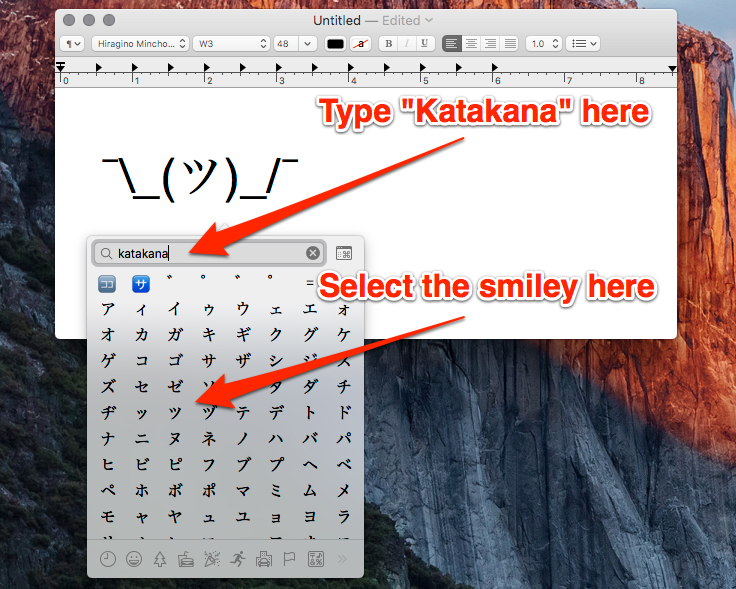
- #Mac keyboard special characters smiley face how to#
- #Mac keyboard special characters smiley face mac#
- #Mac keyboard special characters smiley face windows#
The interactive display will appear, showing all the keyboard symbols and altering the view in real time when you use modifier keys. Now you can click on the language flag in your menu bar and choose Show Keyboard Viewer.
#Mac keyboard special characters smiley face mac#
Luckily, it’s easy to show all Mac key symbols at once:
#Mac keyboard special characters smiley face how to#
Truth is there are many more like this and below we’ll explore different ways of how to type copyright symbol on Mac or any special characters Macs allow, where to find Apple keyboard symbols, and whether there’s an emoji keyboard on Mac.Įven if you’ve been using your Mac for a while, it’s useful to look at all the possible keyboard combinations from time to time to refresh your memory and discover new ways of quickly inputting information. Similarly, a degree symbol on Mac (º) is Option + Zero and a registered trademark symbol on Mac (™) is Option + 2.
#Mac keyboard special characters smiley face windows#
Unfortunately, Apple could do a much better job of shining light at this functionality.įor example, if you want to get a copyright symbol on Windows (©), you need to type in Alt 0169 - whereas, a copyright symbol on Mac is just Option + G. Instead, all of the most popular Unicode characters can be typed in right from the keyboard. If you’ve just recently switched from Windows, you should know that Macs don’t really use alt codes to type special symbols. Whether you’re new to Mac or have been using it for years, highly specialized things like shortcuts, special Mac symbols, and accented characters might result in a web investigation spiralling out of control. Whether for convenience or necessity, MacOS makes it easy to dictate what you need.Forget retyping.

Emojis: Say the name of the emoji, such as “smiley face,” “frowny face,” or “winky face.”įor a complete list, take a look at the Apple support page for dictation commands on Mac.Symbols: Say the name of the symbol or character, like “ampersand,” “asterisk,” “at sign,” “caret,” and “percent sign.".Punctuation: Say the name of the punctuation mark, such as “comma,” “period,” “question mark,” “open parenthesis,” and “close parenthesis.”.To include punctuation marks, symbols, and special characters, use the following: All caps off: Return to the default letter case.All caps on: Format the following phrase in all uppercase letters.All caps: Format the following word in all uppercase letters.Caps off: Return to the default letter case.Caps on: Format the following in title case.Tab key: Move the cursor to the next tab.Here are some common commands you’ll need: Common dictation commandsĪs you speak your text, you’ll likely need to perform actions like starting a new paragraph and inserting punctuation marks. Step 4: To stop using dictation, click Done below the microphone icon, enter the keyboard shortcut, or press your Return key.

Step 3: To change the language while you’re dictating, click the current language below the microphone icon and select a new one. Step 2: Press the key combination or choose Edit > Start Dictation from the menu bar, and you’ll see a small microphone icon appear on the screen.īegin speaking, and you’ll see your text appear in the app and the icon fluctuate for volume as you speak. Step 1: Place your cursor in the app where you want to speak the text. Once you have dictation enabled, you can simply use the keyboard shortcut to begin using it. Should you choose to turn off keyboard dictation later, return to the Keyboard settings in System Preferences and select Off on the Dictation tab. When you finish, close the System Preferences window, and you’re set. Step 7: To use a specific microphone for the input, click the Drop-Down Arrow below the Microphone icon on the left.

You can also set your own keyboard shortcut by selecting Customize and entering the combination you want to use. Step 6: To use a different keyboard shortcut to turn on dictation, click the Shortcut drop-down box and choose the one you want. Step 5: To use a different language, click the Language drop-down box and either pick a language from the list or select Customize to add one. If you want to continue, click Enable Dictation. Step 4: You’ll see a pop-up message letting you know that what you dictate will be sent to Apple to convert it to text. Step 2: Select the Dictation tab in the keyboard settings. Step 1: Open your System Preferences using the icon in your Dock or the Apple icon in the menu bar, and choose Keyboard. The keyboard dictation is a feature that you need to turn on in order to use.


 0 kommentar(er)
0 kommentar(er)
